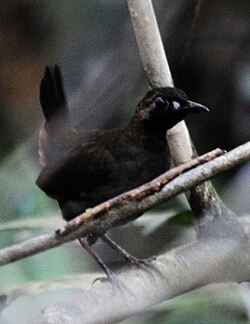Black-faced antthrush
| Black-faced antthrush | |
|---|---|

| |
| Scientific classification | |
| Kingdom: | |
| Phylum: | |
| Class: | |
| Order: | |
| Family: | |
| Genus: | |
| Species: | F. analis
|
| Binomial name | |
| Formicarius analis d'Orbigny and Lafresnaye, 1837
| |
The black-faced antthrush (Formicarius analis), is a passerine bird.
Distribution and habitat
It is a common and widespread forest bird in the tropical New World, from southern Mexico through Central America to the northern regions of South America. It occurs in Colombia, Venezuela, Trinidad and Brazil, and the Amazon Basin with the exception of the northwest region.
Description
The black-faced antthrush is similar in general appearance to a rail, with a dumpy body, horizontal carriage, stout bill and short cocked tail. It walks rather than hops, with a jerky motion again reminiscent of a rail. It is typically 18–19 cm long, and weighs 59 g. The upperparts are rufous brown, and the underparts are paler brown, except for the black face and throat, and rufous under the tail and behind the eye. The sexes are alike in plumage.
Behaviour
The antthrush builds a leaf-lined nest in a cavity in a hollow branch or stump in which two white eggs are laid. It is an insectivore which feeds on ants and other insects. It is quite terrestrial, feeding mainly on the ground. It will follow columns of army ants. The call is a loud whistle followed by a series of 2–10 descending whistles, WHU! wu-wu-wu-wu-wu-wu-wu-wu-wu.
Taxonomy
The subspecies F. a. hoffmanni is sometimes considered a full species - the Panamanian antthrush. The subspecies F. a. moniliger is sometimes considered a full species - the Mayan antthrush or Mexican antthrush.
References
- Birds of Venezuela by Hilty, ISBN 0-7136-6418-5
- ffrench, Richard (1991). A Guide to the Birds of Trinidad and Tobago (2nd ed.). Comstock Publishing. ISBN 0-8014-9792-2.
External links
- Black-faced antthrush videos on the Internet Bird Collection
- Black-faced antthrush photo gallery VIREO
- IUCN Red List least concern species
- Formicarius
- Birds of Central America
- Birds of the Yucatán Peninsula
- Birds of Mexico
- Birds of Brazil
- Birds of the Amazon Basin
- Birds of the Guianas
- Birds of South America
- Birds of Bolivia
- Birds of Colombia
- Birds of Ecuador
- Birds of Peru
- Birds of Venezuela
- Birds of Trinidad and Tobago
- Animals described in 1837

